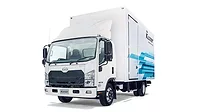Distribution
Light-duty electric vehicles offer an affordable entry-point
Truck manufacturers announce new programs, vehicles

Medium-duty (and larger) electric trucks can, no doubt, be a significant investment for any delivery operation, but distributors are able to dip their toe into the zero-emissions waters with a range of offerings in the realm of electric light-duty vehicles — which are especially effective in urban markets where fleets stand to realize the most significant benefits of EV technology in general.
Among light-duty EVs currently operating on the market is the Ford E-Transit van, which first made its North American debut just more than a year ago. And, citing data from S&P Global Mobility, USTIPNet, Ford Pro touts the E-Transit as the best-selling cargo van in the United States. Between the vehicle’s launch in early 2022 and the year’s end, Ford reports that it sold about 6,500 E-Transit vans.
In February, the company announced an upgrade to the E-Transit — the digital rearview mirror, featuring a high-definition monitor that displays a panoramic view of the area behind the van, enabling drivers to spot cyclists, pedestrians and other vehicles, even when a bulkhead, cargo, passengers or windowless rear doors are in the way.
In March, Ford Pro unveiled a new program designed to help fleet managers understand tax credits offered under the Inflation Reduction Act. The company is working with Ernst & Young to provide complimentary information to learn about tax credits for which they might qualify. The service includes a one-time, 30-minute session for any customers that have been assigned a Ford Fleet Identification Number (FIN).
That same month, Mitsubishi Fuso announced that it has opened orders for its fully remodeled all-electric light-duty eCanter truck. The newly remodeled version of the eCanter — initially launched in 2017 — adopts the eAxle, which integrates the motor with the rear axle, enabling a reconfiguration of the drivetrain. The drivetrain now is more compact, which has made it possible to expand the chassis lineup from the current single option to a total of 28 variants, the company says. The vehicle has been engineered with a modularized battery design that can accommodate a range of one to three battery modules based on the wheel base, it adds. It’s also equipped with new functions that reduce battery consumption during heating usage in cold climates, it says.
Currently, the new upgrades are available in the Japanese market.
The Mitsubishi Fuso news follows other major electric vehicle news to come out of Japan: Last year, Isuzu, Toyota Hino and Commercial Japan Partnership Technologies Corp. (CJPT) announced that they would jointly plan and develop light-duty fuel cell trucks for the mass market.
Finally, there’s been a significant development in Germany, by way of Mercedes-Benz. The new Mercedes-Benz eSprinter enjoyed its market debut in February, but before that it achieved a milestone during the test-drive phase, it says. The eSprinter completed a 475 kilometer (nearly 300 mile) test drive from its home base in Stuttgart Germany to Munich and back on a single battery charge and no need to recharge over the course of the entire journey, it notes. The vehicle consumed 21.9 kWh for each 100 kilometers during the test run, it says. The company launched the eSprinter with three different battery sizes, the largest of which being the one that completed the long-distance test drive. Stateside, the eSprinter is being produced in Charleston, S.C., in addition to European production in Düsseldorf and Ludwigsfelde, Germany.
Looking for a reprint of this article?
From high-res PDFs to custom plaques, order your copy today!





